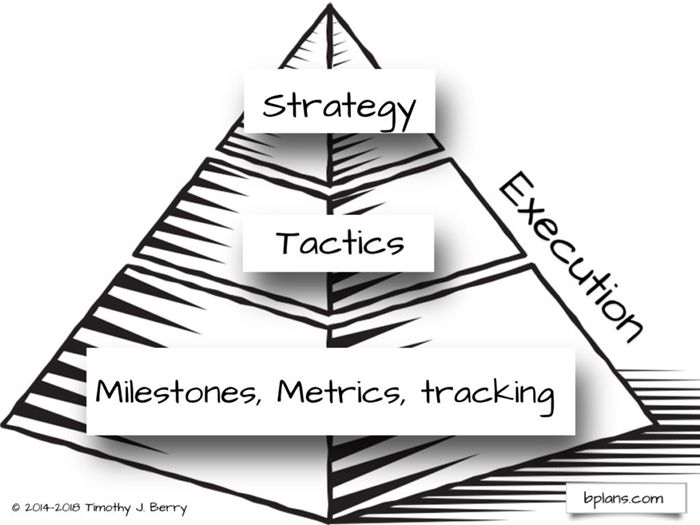Strategy Is Useless Without Execution
It happens often. You take your team away from the routine, brainstorm, and develop a brilliant new strategy for your business. But when you return to the routine, the strategy gets overshadowed by the routine. Nothing changes.
The plan was brilliant on the whiteboard but failed to translate to the real world. What went wrong?
Tactics are measurable steps toward a strategic goal
A business strategy is meaningless without execution. Don’t leave the whiteboard without developing key tactics. Ensure that the chosen execution tactics directly serve your strategic goal. Each action taken should align with your overall business strategy.
I use the pyramid image below to explain strategy, tactics, and execution.

Strategy is focus. It’s a collection of choices that narrow aim to target markets and with product or service offerings that match both target market and own identity. Therefore, strategy is deciding what you are not doing; like who isn’t in your market and what products you aren’t going to offer.
Tactics are specific and practical decisions taken to execute strategy. For example, choosing to target high-end less price sensitive market segment is strategy. Pricing is tactic. Choice of channels and marketing messages are tactics.
Concrete specifics, milestones, budgets, tasks, responsibility assignments, tracking, and following up make up bottom of the pyramid. They have to be defined in detail and should also be measurable.
Execution is a good word for both of lower two levels of the pyramid, taken together. Execution includes tactics and concrete specifics.
For example, in How to Develop Your Business Strategy, posted here a few days ago, I used a bicycle store as an example of how strategy leads logically to execution. Let’s start with strategy:
Imagine the difference between a bicycle retail store owned and operated by a former professional bike racer, and another owned and operated by a couple with children who like bicycles as a family activity. The first one will probably stock and sell expensive, sophisticated bicycles for racing enthusiast and extreme long-distance or mountain biking hobbyist. The second will probably emphasize bicycles for children, bike trailers, carriers, and accessories for families. Whichever direction bike store takes is strategy, and it won’t work without execution, tactics. In this case, tactics would include what to stock in store and what not to stock, general pricing level, promotions, bundles, participation in local events, tone and content of social media, advertising messages and media, even how to position service. And, aside from tactics, it takes concrete specifics such as milestones (dates and deadlines) and budgets.
I’m amazed that so much of what I see written about business plans includes strategy but skips execution. In truth, tactics are usually there, broken into sections such as marketing plan, product plan, financial plan, and management plan. And better business plans also include concrete specifics, presented as major milestones, metrics, dates, budgets, etc. Alignment means tactics match strategy and concrete specifics match tactics.
So, good news is that we actually do think through tactics and include them in plan but bad news is we don’t always articulate relationships between strategy and tactics. And we don’t always add in specifics. We lose strategic alignment, which is coordination between plan and execution.
What’s strategic alignment? It’s right hand knowing—and working with—what left hand is doing. So if bike store owner says her business strategy is to focus on family market, then she shouldn’t stock fancy bikes, she can’t charge upscale pricing, she can’t advertise in extreme sports or extreme fitness websites. Her social media content is about kids and family, not racing. She takes her store to local activities like charity bike rides and school parades, not triathlons.
Lack of alignment happens way too often. I spent years consulting with Apple Computers helping dealers counter so-called “box pushers” in big-box stores by focusing on small business and really good service. However, way too often, they’d claim that as strategy in meetings but still offer only mediocre service. The good ones remodeled their stores to add big service counter and put employees in white coats behind counter. And they bundled installation into sales and added white vans plastered with “another installation” banners on side.
Hello!
I’m Andrew Brooks, a seasoned finance consultant from the USA and the mind behind phonenumber247.com.
My career is built on a foundation of helping individuals and businesses thrive financially in an ever-changing economic landscape. At phonenumber247.com, my aim is to demystify the complex world of finance, providing clear, actionable advice that can help you navigate your financial journey with confidence. Whether it’s personal finance management, investment strategies, or understanding the nuances of market dynamics, I’m here to share insights and tools that can propel you towards your financial goals.
Welcome to my digital space, where every piece of advice is a step closer to financial clarity and success!
